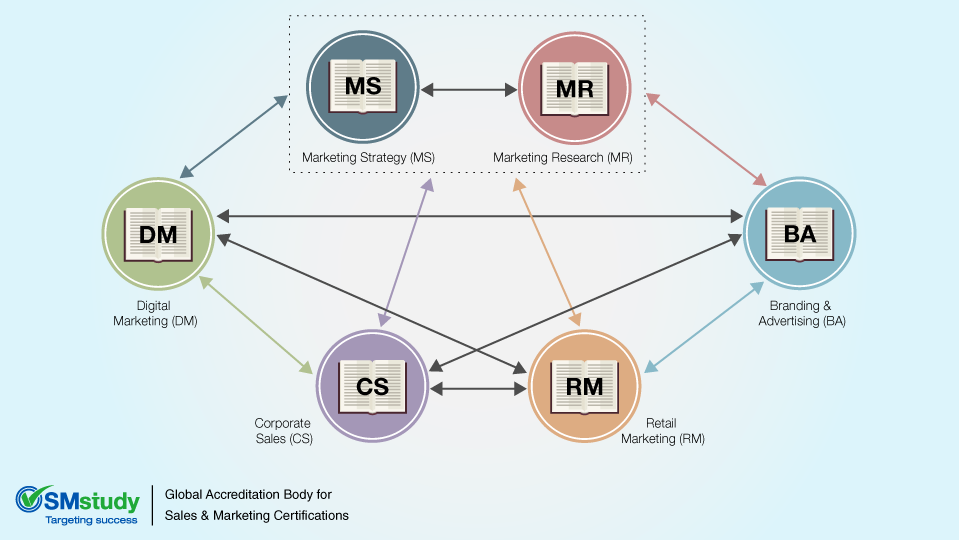There are six Aspects of Sales and Marketing, and you can read about them all in the SMstudy® Guide.
- Marketing Strategy
- Marketing Research
- Digital Marketing
- Corporate Sales
- Branding and Advertising
- Retail Marketing
These six aspects are based on the six most common and distinct career fields related to sales and marketing. You can see here how they interact with each other.

The dotted lines encase the “Essential Marketing Aspects,” both of which are mandatory and should be used to define, measure and provide direction for the overall marketing efforts of a company.
The other four Aspects are “Optional Marketing Aspects” because one or more of them could be used by a company to reach its marketing goals and, in some instances, not all are applicable. For example, a small company creating phone apps or online games might only use Digital Marketing; another company manufacturing heavy equipment might use Corporate Sales only; and a large consumer goods company or global fashion chain might decide to use all four Optional Marketing Aspects to reach its marketing goals.
Marketing Strategy describes how the Aspect of Marketing Strategy aligns with a company’s overall Corporate Strategy and acts as a unifying framework to define and analyze the other Aspects of Sales and Marketing. It also helps align all the marketing resources among all Aspects.
Marketing Research explains the concepts of Marketing Research and provides a framework for conducting marketing research and to analyze Sales and Marketing data. It also demonstrates how marketing research findings can help the marketing team conceptualize and finalize product features and other components of a company’s Marketing Strategy.
Digital Marketing includes all marketing activities that use electronic devices connected to the Internet to engage with customers such as computers, tablets and smartphones. These include activities related to creating and managing effective websites and mobile apps as well as promoting a company’s products and brand through various online channels that help meet the company’s marketing objectives.
Corporate Sales outlines the best practices and processes to be followed for effective business-to-business sales. It provides guidance on activities related to building and maintaining strong business relationships.
Branding and Advertising includes concepts of product branding, consumer behavior, marketing communication, and public relations. Branding is the process of creating a distinct image of a product or range of products in the customer's mind. This image communicates the promise of value the customer will receive from the product or products. Branding should remain consistent across all channels of customer communications.
Retail Marketing presents concepts of all marketing activities related to persuading the end customer to purchase a company's products at a physical retail outlet or store, and efficiently managing the supply chain and distribution channels to improve the reach and sales for a company’s products.

